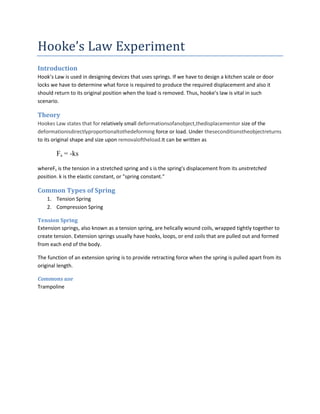
Hook's law experiment (student)
- 1. Hooke’s Law Experiment Introduction Hook’s Law is used in designing devices that uses springs. If we have to design a kitchen scale or door locks we have to determine what force is required to produce the required displacement and also it should return to its original position when the load is removed. Thus, hooke’s law is vital in such scenario. Theory Hookes Law states that for relatively small deformationsofanobject,thedisplacementor size of the deformationisdirectlyproportionaltothedeforming force or load. Under theseconditionstheobjectreturns to its original shape and size upon removaloftheload.It can be written as Fs = -ks whereFs is the tension in a stretched spring and s is the spring's displacement from its unstretched position. k is the elastic constant, or "spring constant." Common Types of Spring 1. Tension Spring 2. Compression Spring Tension Spring Extension springs, also known as a tension spring, are helically wound coils, wrapped tightly together to create tension. Extension springs usually have hooks, loops, or end coils that are pulled out and formed from each end of the body. The function of an extension spring is to provide retracting force when the spring is pulled apart from its original length. Commons use Trampoline
- 2. A trampoline uses many extension springs to create the bouncing effect. Every time someone jumps on the trampoline, the extension springs are pulled apart and force is exerted. This makes the extension spring want to go back to its original length, thus giving the inertia to fly into the air.
- 3. Procedure 1. Push the crosshead above until and unless the spring becomes slack. 2. Set the cell reading to zero and note the position of the double-edged pointer 3. Release the cross head and let it come to rest so that the weight and the tension becomes equal. 4. Tap the equipment so that any stoppage due to friction is released and the equipment comes to rest at the position given in point 3. 5. Next note the reading of the scale pointer. 6. Turn the screw on the cross head so it stretches the spring 2 mm (0.002m) and take the reading from the Load cell. 7. Repeat in 2 mm (0.002 m) steps, until you reach the end of the Crosshead travel. Tips: The scale has two edges. Look across both of these to reduce the parallax error. To remove the pretension in the spring (if it not appropriate for your course) pull the spring by the loops until the coils no when the spring is relaxed.
- 4. Conduct the experiment and note down its reading Observ. Scale No Distance Reading (mm) (N) 1 2 3 4 5 6 7 8 9 10 11 12 13 14 15 16 17 18 19 20 21 22 23 24 Draw the best fit curve (line). What is the trend that you observe? Determine the spring constant. Using graph! Determine the y-intercept. What does this indicate? Draw the free body diagram of tension spring apparatus, demonstrating all the forces acting on it if the Load Cell shows a reading of 5 N, when it has reached an equilibrium state.
- 5. Compression Practical Example: Pogo stick A pogo stick is a toy that works as an exercising tool without children realizing their fun is actually healthy. A child uses his legs, abdomen and arms to operate a pogo stick with repeated movement, exercising each muscle. A pogo stick is a simple machine called a spring that uses the weight of the child pressing down on the spring to cause the spring to push the child up into the air. Procedure 1. Take up the slack in the spring by using the screw on the crosshead until the load cell pointer just begins to move 2. Set the load cell to zero and note the position of the double-edged pointer. 3. Turn the screw on the crosshead so it compresses the spring 2 mm (0.002m) and take a reading from the Load cell. 4. Repeat in 2mm (0.002 m) steps until you reach the end of the crosshead travel or when the spring is fully compressed. Tips: The scale has two edges. Look across both of these to reduce the parallax error.
- 6. Conduct the experiment and note down the observations. Observation Scale Reading on Scale Reading – Compression number Compression (mm) Intial Reading (mm) force Recorded(N) Draw the best fit curve (line). What is the trend that you observe? Calculate k of the above experimentUsing the graph Draw the free body diagram showing all the forces acting on the apparatus when the spring balance is showing the reading of 3 N.
